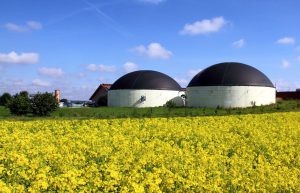There is a worldwide trend towards electricity generation from renewable energies. During the next ten weeks we will explore the following commercially available renewable energy technologies: Biomass, geothermal energy, solar energy, hydropower and wind energy.

Biomass
Biomass is created when plants grow through a process called photosynthesis. During that process plants transform carbon dioxide (CO2), water and sunlight into biomass and oxygen. Roughly 1 percent of the solar energy that reaches the earth surface is used for plant growth. Humans have been using biomass since prehistoric times, primarily as food and energy source. The latter was mainly biomass in form of wood as a fuel. Fossil energy carriers such as hard coal and lignite have developed from biomass as well.
Biomass used for energy purposes can be distinguished in three main forms:
- solid,
- liquid and
- gaseous biomass.
Following a respective drying process solid biomass is suitable for direct combustion. The heat that is released during that process can then be used for driving other processes, e.g. a steam power process or in a process or district heating grid. Solid biomass has a calorific value of about 4.8 MWh per ton of dry plant material. This is roughly half the value of hard coal.
Pressing plants or some of their parts which possess high oil content results in liquid biomass, e.g. rapeseed, sunflower seeds. Fermentation and distillation of sugar crops are further methods for obtaining liquid biomass. The products of these processes, oil or ethanol are mainly used in the transportation sector.
Generating electricity is limited to combustion motors and smaller power plants and co-generation units for decentralized power and heat generation.
However, gases obtained from biomass are the most important input for electricity generation from biomass. The process of creating biogas will be dealt with next week.



